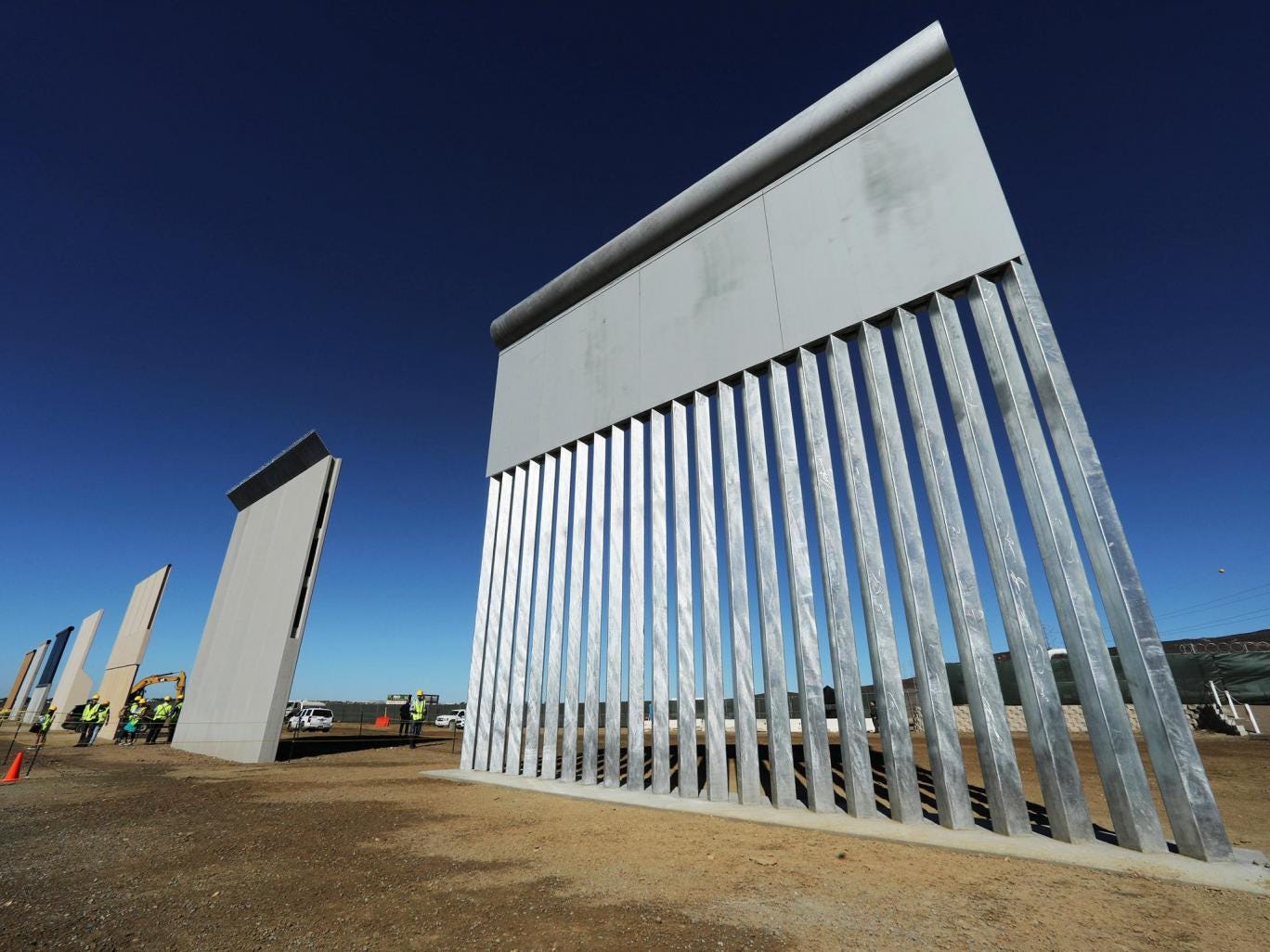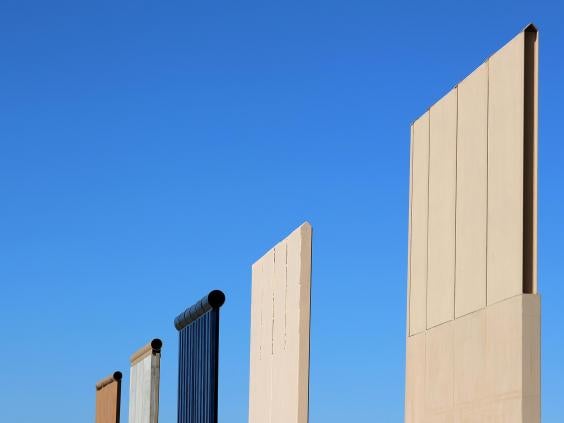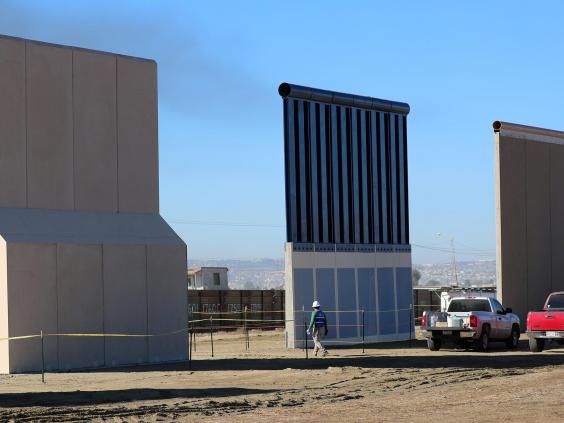Results 1 to 1 of 1
Thread Information
Users Browsing this Thread
There are currently 1 users browsing this thread. (0 members and 1 guests)
-
11-13-2017, 03:44 AM #1
Trump Border Wall Prototype: Which design will win contract to help keep out Mexicans
Trump Border Wall Prototype: Which design will win contract to help keep out Mexicans?

Standing like monoliths between San Diego and Tijuana, the border wall prototypes alone have reportedly cost the Border Control Agency $3.3m (£2.5m) / Photography by Reuters With prototype contracts averaging at around $400,000, there’s hot competition for the chance to design the wall
24 hours ago
The eight prototypes for Donald Trump’s “Great Wall” now stand solid on the US-Mexico border – an open sign of hostility to the residents of Tijuana, an ominous and foreboding statement of unwelcome.
For onlookers they stand as real, tangible evidence that Trump intends to follow through with the central promise to his presidential campaign.
The construction, which is set to cost $21.6bn and take three years to complete, could end up being the most expensive capital project in US history.
It’s no surprise that the Trump administration has found no difficulty in attracting contractors hoping to get a piece of the action.
The prototypes, erected in late October, will now be subject to months of rigorous testing to ensure no one is able to slip through the cracks.
The brief is to create a wall that can withstand up to an hour of high impact drilling, sawing and hammering. In order to minimise tampering all exposed fixtures must be on the US side – while remaining visually pleasing (on just the US side of course) and fit into local surroundings.
The minimum height requirement on the prototypes is 18ft, though many it appears have scarcely strayed away from around the 30ft mark. All structures must extend at least 6ft below ground (though patrol officers have alluded to reporters that many extend much further than that).
Creatively, it appears border enforcement has given designers free rein. All eight prototypes vary greatly in material, shape and colour. Though the enforcement agents have insisted the wall must be mechanically impossible to scale, the construction companies have interpreted this in different ways.
Some have included Berlin Wall-esque tubing at the top to prevent homemade ladders or ropes from being able to make purchase. Others have created ramps, and wider bases. Of the six bidders for the project, just one is based outside of the United States.

WG Yates and Son: based in Philadelphia, Mississipi, the family-owned construction company is one of the country’s biggest, having dabbled in everything from airports and luxury apartments to prisons.
It made the Forbes list of America’s 200 largest privately owned companies in 2015.
Yates was contracted to create two prototypes, the first made of corrugated metal panelling and the second concrete. Both have a large round pipe at their height to prevent scaling. They appear to look the same on either side of the border.
Texas Sterling Construction: the contractors from Houston, Sterling describes itself as the “premier” civil contractor in Texas, and specialises ordinarily in highways and bridges. Its design greatly differs depending on which side of the border you are on.
The US side uses brick patterning to fill the “aesthetically pleasing” quota, while the Mexican side is made up of metal panelling with barbed wire spikes hanging over the top.
Caddell Construction: another company to land two commissions, Caddell is based in Montgomery, Alabama. Its website features testimony from the warden of a prison in its home state as “the best construction team of his career”. The company has recently been establishing itself further afield, winning contracts for US embassies in Athens, Nairobi... and Mexico City.
Caddell’s walls differ greatly. The first is concrete, with a slender neck that expands at the base, but only on the US side – on the Mexican side it is a sheer concrete drop. The second features see-through metal bars at the bottom, with concrete blocks at the top. The second design looks the same on either side of the border.
Fisher Sand & Gravel: Arizona-based Fisher Sand is part of Fisher Industries, which was selected as one of Prairie Business magazine’s 50 best places to work. It appears prepared for the task ahead if its company motto – “We like the TOUGH jobs!” – is anything to by.
Its wall features a gradual slope to the top, making climbing incredibly difficult – the wall looks the same on either side and has been painted brown to fit into local surroundings.

The blue design of ELTA makes it stand out from the rest of the contenders
KWR Construction Inc: Fellow Arizonians KWR created the most expensive prototype on-site. In a statement released on its website after being chosen as one of the eight successful designers, it insisted that if the fence was “inevitable it might as well be built well, and by us”. They carried on their cheery tone by declaring: “All of us can make lemonade out of what some might call a lemon.”
Its design is made of metal, and is see-through to ensure visibility on either side. It features a round pipe at the top.
ELTA North America: ELTA, or Israel Aerospace Industries, is one of Israel’s leading defence contractors, specialising in military aircraft, missiles and target acquisition. It is the only shortlisted bid to come from outside of the US, and the only company which doesn’t specialise in civil construction.
Its wall is the most colourful of the lot, with a pale blue concrete base and an electric blue metal grating at the top.
There isn’t likely to be a single winner to come from the tests on the eight prototypes. Instead the US Border Patrol will take whatever it learns from the tests and incorporate it into a final design.
http://www.independent.co.uk/life-st...-a8046371.html
Support our FIGHT AGAINST illegal immigration & Amnesty by joining our E-mail Alerts athttp://eepurl.com/cktGTn
Similar Threads
-
Border wall prototype contractors selected
By Jean in forum illegal immigration News Stories & ReportsReplies: 2Last Post: 09-01-2017, 06:40 AM -
Border Wall Prototype Lawsuit Expanded to Include San Diego Border Wall
By lorrie in forum illegal immigration News Stories & ReportsReplies: 3Last Post: 07-11-2017, 07:51 PM -
Border agency says it has picked finalists to design wall
By Jean in forum illegal immigration News Stories & ReportsReplies: 2Last Post: 05-13-2017, 12:30 AM -
TEXAS COMPANIES BID TO BUILD $20M BORDER WALL PROTOTYPE
By Jean in forum illegal immigration News Stories & ReportsReplies: 0Last Post: 05-06-2017, 02:04 PM -
Mexicans form human chain along border to protest Trump's wall
By Jean in forum illegal immigration News Stories & ReportsReplies: 1Last Post: 02-18-2017, 01:21 AM


 2Likes
2Likes LinkBack URL
LinkBack URL About LinkBacks
About LinkBacks




 Reply With Quote
Reply With Quote


Ukraine-Israel Bill Secretly Funds Biden's invasion!
04-24-2024, 12:01 PM in illegal immigration Announcements